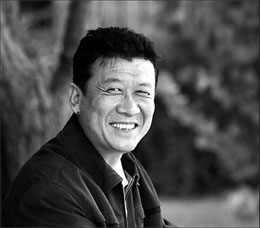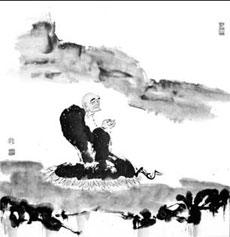Speaking from the soul
On the last day of the World Public Forum staged on the Greek island of Rhodes in early October, a tall Chinese painter brought the roundtable discussion on Chinese issues to a crescendo.
By that point, scholars had discussed Confucianism and the role of China in the multipolar world for two days. Han Xuanzhen made a small stir as he hurried onstage with a huge paintbrush, a plate of Chinese ink and a scroll of xuan rice paper.
|
Buddhist artist Han Xuanzhen. Liu Jun |
The Russian interpreters - top-notch linguists who had worked with Chinese, English and other languages in the United Nations - were at a loss at how to translate Han's rapidly spoken, poetic description of his painting of arhats, the enlightened immortals of Buddhism.
But the Head of Russia's railways Vladimir Yakunin wasn't bothered by the silence in his earphones.
At the forum he helped found five years ago, the Russian billionaire had denied rumors that he planned to run for president. But now, he kept asking his Chinese neighbors what Han was writing.
The four characters Han scrawled on the table - "Wen ming dui hua", which translates as "dialogue of civilizations", or "civilized dialogue" - had aptly summarized the spirit of the forum. Yakunin was immensely pleased by the surprise gift from the painter, who had received great praise from former Chinese President Jiang Zemin.
Greece seems to be a very appropriate setting for the Buddhist artist's demonstration. It was the home of great philosophers, such as Socrates (469-399 BC), who lived during the times of Buddha and Confucius.
With his ink and brush, the Chinese artist, who doesn't speak any foreign language, communicated a powerful message to the forum's participants, who were fully aware of Greece's rich Western history and the historic riches of the East.
But confusion came the next day when a hotel staffer knocked on Han's door. The artist didn't understand what was wrong. Through a friend, he learned that the management wanted him to clean off the ink traces on the table in his room.
Han is a National Grade One Artist, and he practices calligraphy every day. According to the conventions of traditional Chinese painting, an artwork is considered incomplete until it is scrawled with calligraphically scribed poems in black ink and stamped with artistic red seal prints.
Han spent hours scrubbing the table until everyone was satisfied. He took the whole thing in stride, considering it to be just another odd event in his life.
|
Joy of Meditation, by Han Xuanzhen. |
"Treat yourself and others as equal men; then everyone feels comfortable," says Han, 47, who spent most of his time on the island swimming in the Aegean Sea.
Two decades ago, Han wouldn't have imagined enjoying such luxurious leisure. Before spending seven years wandering the mountains creating sketches, Han had earned a decent salary from designing ceramics in his hometown of Yishui, East China's Shandong Province.
But he always battled with an inner yearning to get away. Han's grandfather had donated firewood to temples every winter. And his mother worshipped Buddha every day. These serene images made a deep impression on the young boy.
Upon quitting his job, Han became a "drifter", essentially rendering him a social outcast in the small, enclosed rural county. Han supported himself by working odd jobs, such as painting advertisements for restaurants. Sometimes, he would only allow himself to spend 1 yuan ($0.13) a day.
After years of painting natural scenery, Han gradually came to focus on temple life. Han was amazed by how creative ancient artists had been in depicting nirvana over the past 2,000 years, since Buddhism first spread into China.
Sakyamuni, the founder of Buddhism, is always depicted as solemn, compassionate and benevolent. But the arhats - the disciples of Buddha - are fascinating immortals who are portrayed as expressing their true feelings in ways that seem bizarre to laymen.
"The arhats are romantic. Without romance, there can't be art," Han says.
Han spent five years visiting temples that had preserved arhat paintings and sculptures. He dreamed of painting all of the 500 arhats popular in folklore. This journeys were full of surprises.
He recalls that once he was practicing calligraphy by the river when a man who was walking by struck up a conversation. Han forgot about him until half a year later, when he needed to buy pigments and paper from Beijing. At the capital's railway station, he called the phone number on the man's worn and tattered name card.
A jeep came to pick him up and took him to a simple, guarded hotel.
The official, surnamed Wan, invited him to stay for three days. Han enjoyed himself immensely at the National Museum of Art but didn't bother to learn the identity of his generous host. With Wan's help, Han went to Chengdu, Southwest China's Sichuan Province. Temples there boast some of the country's best arhat sculptures.
From the jeep driver who had picked him up, he finally learned that Wan was the son of China's former Vice Premier Wan Li.
"I had a bias against officials, but he was such an affable person," Han recalls.
|
Walk and sit at ease, by Han Xuanzhen. |
Han seems to ignore the bitter things in life but always remembers those who have helped him. While he was dozing off in the Zhaojue Temple in Chengdu, a master in his 80s came by, surrounded by many monks.
Upon learning of Han's plan, the master patted him on the back of the head and invited him to stay. At dinner, the master picked vegetables for Han and asked if he wanted noodles instead of rice, according to the preference of most northern Chinese.
Han soon learned that he was the abbot of the temple, Venerable Qingding. "I didn't want to trouble them. But Venerable Qingding simply waved his hand and gave me a nod. Without saying a word, he touched my soul with compassion," Han recalls.
In 1989, after 12 years of hard work, Han finally finished the 58-meter-long, half-meter-wide scroll entitled 500 Arhats. Aisin Giorro Pujie, the younger brother of China's last emperor, remarked "well done" after scrutinizing the scroll. "He had seen numerous paintings in the Forbidden City, and he said there were few contemporary painters who specialized in this subject," Han says.
In 1993, the scroll was displayed at the then National History Museum. Then Chinese President Jiang Zemin and Premier Li Peng both praised his work.
"Was Ji Gong one of the arhats?" Jiang asked Han. Ji Gong is a legendary monk who lived in the 12th century, who dressed like a beggar and always helped the poor.
"No. He was born too late and didn't make it to the Arhats Hall," Han replied. The answer amused everyone.
This discussion captured public attention, and a friend helped Han print an album with pictures showing him rubbing shoulders with the national leaders. But Han says he feels "ashamed" to show the album to close friends.
"My parents and the Yimeng Mountain are my background," he told an official who was curious as to how he had become privy to the company of so many VIPs.
The National History Museum offered him 80,000 yuan ($10,600) to include his 500 Arhats into its permanent collection - a rare honor that many artists dream of. But Han declined when he learned that he wouldn't be able to display his beloved work elsewhere.
"While many Chinese artists of his age are embracing globalization, Han has been exploring traditional culture and his spiritual world," said professor Ni Peimin, of Grand Valley State University in the United States, who moderated the roundtable on Chinese issues during the World Public Forum.
(China Daily 11/06/2007 page20)

















